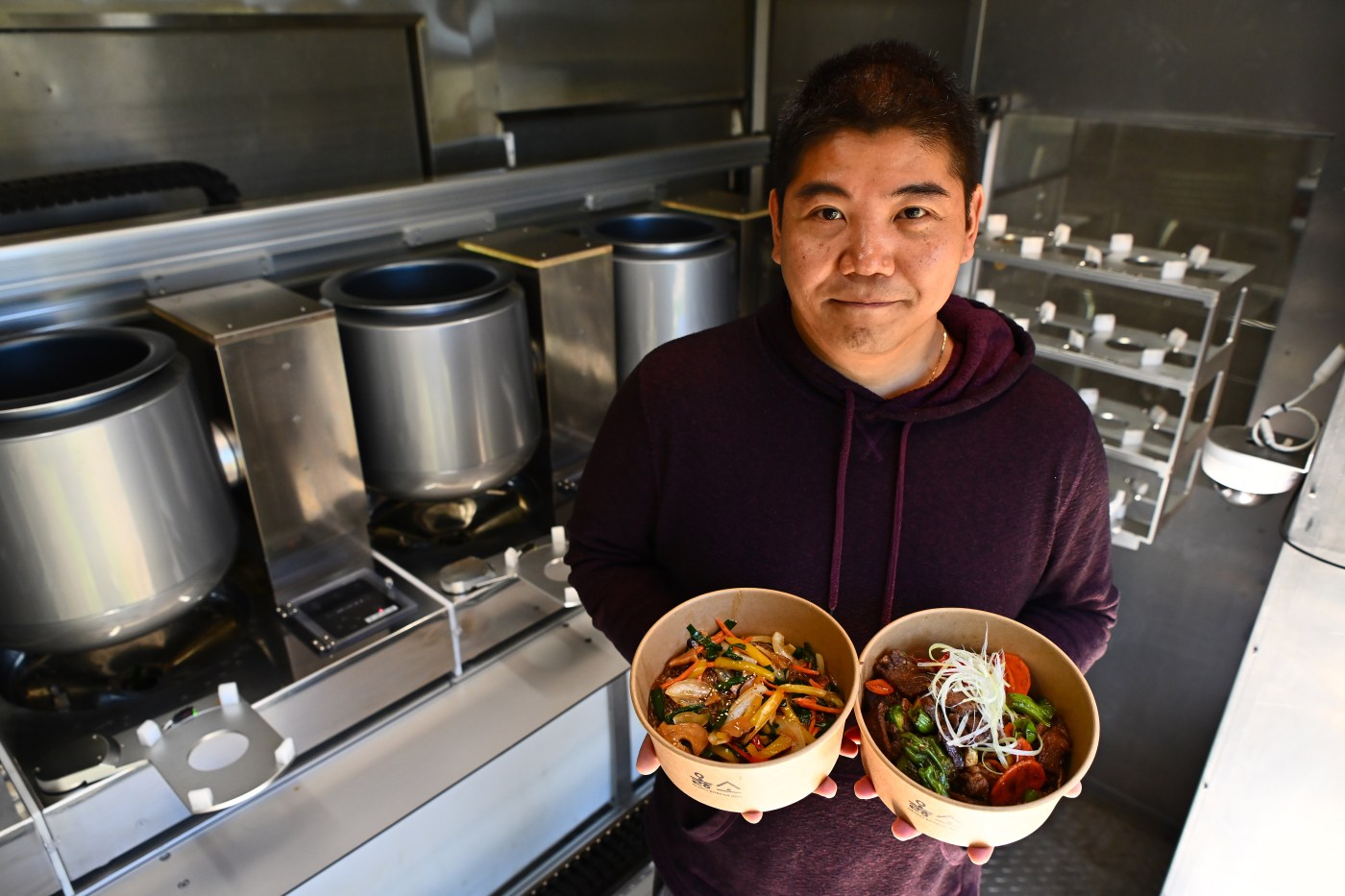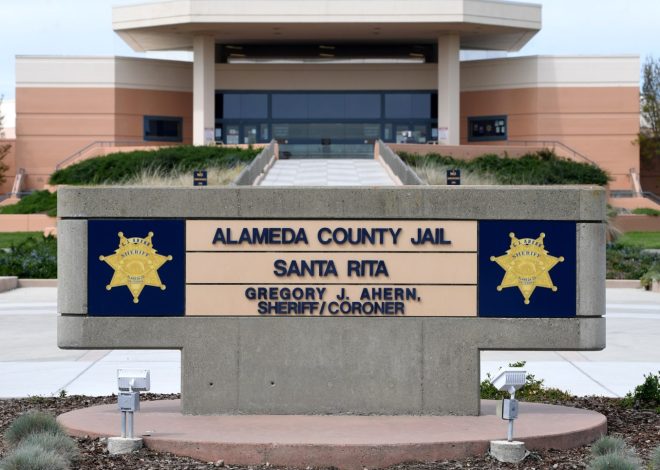
The new crew spicing up the Bay Area food scene: Robots
It’s a scene that once would have been straight out of a science fiction movie — an array of metal machines move in sync to cook up hot bowls of wagyu and pork belly.
The robots belong to the Olhso Korean BBQ & Seafood Truck, a new mobile restaurant that opened for delivery six weeks ago in Foster City. The idea: cut costs by running the truck with just a driver, and cook food on the way to the delivery site to provide hot, fast meals.
Behind the bots is Jay Shin, a former tech investor who’s turned his talents to the food industry. Born and raised in Seoul, South Korea, Shin co-founded Olhso KBBQ with CEO Kish Shin (they aren’t related) and moved with his wife and 11-year-old son to the Bay Area just months ago to supervise the launch.
We recently asked Jay Shin about Olhso KBBQ. His answers were edited for length and clarity.
Q: How did the idea for a robotic food truck come about?
A: I was a big foodie for all my life — as you can see, I’m a pretty big guy. I’m also a pretty good cook. So I’ve always had an ambition to do some type of a restaurant business, despite starting my professional career as a financial investor. I spent 12 years as a global tech investor, so emerging technology is something that I always put my emphasis on — what’s the new trend, what’s the new technology?
I covered robotics for six years as an investor. Beforehand, robotics were only used in upstream industries, such as automobile manufacturing, shipbuilding, but I think 2016-17 was actually the tipping point, the robotics getting cheaper, and smaller. So many applications started to float around, and that was the moment when I realized, okay, the robotics industry is finally coming down to the downstream industries.
We started our company in 2019, and my business partner, who’s also our co-founder and CEO, Kish, was in charge of a Korean barbecue franchise restaurant in the States. Kish has experience in the US running this business, and I myself have an insight of what type of robotics needs to be made.
An electric automatic cooking wok transfers the cooked ingredients into a bowl while being prepared inside the OLHSO Korean BBQ & Seafood Truck in Foster City, Calif., on Friday, July 26, 2024. This is a new meal delivery service model in which the food is fully cooked autonomously by a computer while providing the customer hot fresh cooked meals in a timely manner. (Jose Carlos Fajardo/Bay Area News Group)
Q: Why cook the food with robots?
A: The US restaurant industry’s profit margin has only decreased every year. In the next five to seven years, US restaurants will probably go to the zero sum game.
And the outcome of that is the restaurant owners don’t want to hire more staff anymore, right, because the margin is so low.
Samsung headquarters is adopting our food robotics into their cafeteria — they came up to us and said, hey, we have 1500 people in the cafeteria to serve our employees, lunch, breakfast and dinner in the campus. And the turnover ratio for the staff is over 90%, so they need to rehire 1400 laborers again and again every year. And it is just so costly because, you know, in the kitchen, you need staff training for two, three months, and then they get used to the menu, and then they work for a couple months and then they leave. This is very repetitive. And everywhere in the US restaurant industry, whichever country you’re talking about, this is a very serious problem.
If you look into our truck, there’s a fully automated robotic kitchen inside. And we only need one employee, which is a driver.
Company cofounder Jay Shin opens the side door of the OLHSO Korean BBQ & Seafood Truck in Foster City, Calif., on Friday, July 26, 2024. This is a new meal delivery service model in which the food is fully cooked autonomously by a computer while providing the customer hot fresh cooked meals in a timely manner. (Jose Carlos Fajardo/Bay Area News Group)
Q: What’s the benefit to customers?
A: So actually, the meal delivery industry is having a bigger problem than just the restaurant industry because number one, the food quality is the worst among all meal service categories because it takes 45 to 90 minutes, so your food is getting cold. And still you need to pay like 25-30% on top of it with the associated delivery fee and service charge.
So what we have accomplished with a robotic kitchen inside our truck is that it can cook while en route to the customer’s location, so our food is getting done at the same time of arrival. So we guarantee that the food we provide is always hot and fresh at a much more affordable price.
Our chef is, by the way, selected as a top Korean barbecue chef in Korea. So what we wanted to do is actually replicate his recipe in our robotic kitchen, so that it’s always pre-programmed. Then what happens is, no matter, whichever orders, we make sure that the food quality is always the same as the chef has originally intended it to be. So there’s no error; it’s always consistent output.
Q: Why Korean barbecue?
A: Kish, having knowledge of Korean barbecue, knew how explosive this barbecue is going to be in the US. He was actually enjoying that moment in 2016, 17, 18, when the boy group BTS was really successful in the States. So BTS was the main trigger of putting Korean barbecue on the map in the US. We saw this opportunity and we thought, if we were to do one Korean food business in the States, it has to be Korean barbecue, because that’s going to be the representation of Korean food.
Just like sushi represents Japanese — there are so many other Japanese foods, but what do you think about when you think of Japanese food? Probably sushi will pop up in your head first, right? So I think Korean barbecue is that type of like strong keyword that we want to hold onto as a business model.
The Wagyu Galbi meal for two people is shown from the OLHSO Korean BBQ & Seafood Truck in Foster City, Calif., on Friday, July 26, 2024. This is a new meal delivery service model in which the food is fully cooked autonomously by a computer while providing the customer hot fresh cooked meals in a timely manner. (Jose Carlos Fajardo/Bay Area News Group)
Q: Do you remember the first time you tried food made by the robots?
A: It was horrible. Initially, I said, what was the whole point of making this expensive robot to make such bad quality food? I mean, it’s like fast food quality. Then what’s the whole point of trying to make this as a robotic kitchen?
The food quality got developed over time.
Related Articles
Meet San Jose Mineta International Airport’s new aviation director
Do we really understand coffee? California’s new Coffee Research Center says ‘No’
San Leandro tech startup to sell drones the size of several cars, flying 600 miles at a time
This 26-year-old Silicon Valley tech worker uses her impostor syndrome as novel inspiration
Big paws to fill: Meet Contra Costa’s new director of Animal Services
Q: How are people liking the food?
A: The most common feedback that we get is whenever people taste our food, they go, ‘Wow, this is restaurant quality — this food is as good as a high end Korean barbecue restaurant in the States.’ And that’s given me a lot of confidence.
Q: You said you have an 11-year-old son; is he a fan of the mobile restaurant?
A: Yeah, of course. He says it’s very cool. I mean, kids love robotics.
Jay Shin
Age: 41
Position: Co-founder and CSO/CFO of Olhso Korean BBQ & Seafood
Residence: Menlo Park
Education: Hanyang University, majored in electrical engineering
Hometown: Seoul, South Korea
5 things to know about Jay Shin
Shin owns two dogs, Lea and Gundam.
He plays basketball and the video game Overwatch with his family to de-stress.
His favorite Olhso menu item: Dak Galbi (spicy stir-fried chicken).
His favorite part of living in the Bay Area: the weather.
He met his co-founder, Kish Shin, while attending high school in Virginia.


